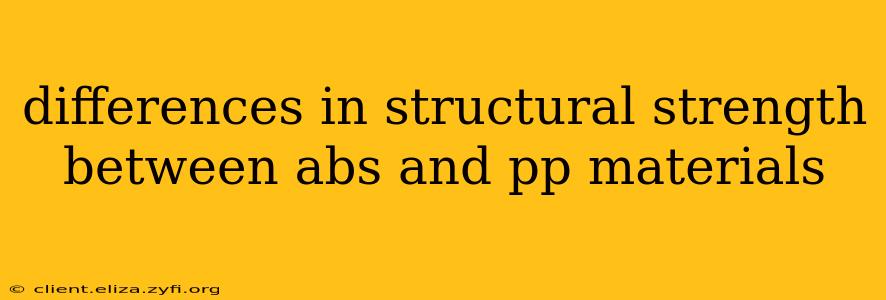Acrylonitrile Butadiene Styrene (ABS) and Polypropylene (PP) are both popular thermoplastic polymers used in a wide range of applications, from consumer products to automotive parts. However, their structural strengths differ significantly, making them suitable for different purposes. Understanding these differences is crucial for selecting the right material for a specific application.
What is ABS?
ABS is a terpolymer made from three monomers: acrylonitrile, butadiene, and styrene. This unique composition gives it a desirable combination of properties, including high impact resistance, good chemical resistance, and relatively easy processing. The butadiene component provides impact strength, while the acrylonitrile contributes to chemical resistance and strength, and the styrene enhances stiffness and processability.
What is PP?
Polypropylene (PP) is a thermoplastic polymer produced from the polymerization of propylene. It's known for its lightweight nature, excellent flexibility, and good chemical resistance. There are several types of PP, including homopolymers (hPP) and copolymers (rPP), each with varying levels of stiffness, impact resistance, and heat resistance.
Comparing the Structural Strength of ABS and PP
The key differences in structural strength between ABS and PP lie in several areas:
1. Impact Resistance
ABS generally boasts superior impact resistance compared to PP. This means ABS can withstand sudden shocks and impacts better without breaking or fracturing. This makes it ideal for applications requiring high durability, like protective casings or automotive parts. While PP is relatively impact-resistant, it tends to be less resilient than ABS, especially at lower temperatures.
2. Tensile Strength
Tensile strength, or the ability to withstand pulling forces, is generally higher in ABS than in PP. However, the specific tensile strength values can vary greatly depending on the grade and processing method of each material. High-performance grades of both materials can achieve substantial tensile strength.
3. Flexural Strength
Flexural strength, or the ability to withstand bending forces, also shows a slight advantage for ABS over PP in many cases. This means ABS can withstand more bending stress before failing. Again, specific properties are dependent on the specific grade and processing.
4. Heat Resistance
PP generally demonstrates better heat resistance than ABS. While both are thermoplastics, PP has a higher melting point and can withstand higher temperatures before softening or deforming. This is a crucial factor in applications involving exposure to high temperatures.
5. Stiffness
ABS tends to be slightly stiffer than PP, meaning it resists deformation under load better. However, specific stiffness varies according to the type of PP and ABS used.
Which Material is Stronger? It Depends!
There's no single definitive answer to which material, ABS or PP, is "stronger." The superior material depends entirely on the specific application and the type of stress it will encounter. ABS often excels in applications requiring high impact resistance and strength under sudden loads, while PP might be preferred where flexibility, heat resistance, and lightweight properties are paramount.
Frequently Asked Questions
What are the main applications of ABS and PP?
ABS finds use in applications requiring high impact resistance, such as protective housings for electronics, automotive parts (dashboard components, bumpers), pipes, and toys. PP is used extensively in food packaging, automotive parts (interior trim, bumpers), medical devices, and household appliances, often chosen for its flexibility, lightweight nature, and chemical resistance.
Can ABS and PP be recycled?
Both ABS and PP are recyclable, although the recycling process and market for recycled material can vary depending on the region.
How do the costs of ABS and PP compare?
Generally, PP tends to be less expensive than ABS, which can influence material selection in cost-sensitive applications.
What are the limitations of ABS and PP?
ABS is susceptible to UV degradation, and its chemical resistance is not as high as some other polymers. PP can be brittle at low temperatures, limiting its use in cold environments. Both materials are flammable and should be handled according to safety guidelines.
By considering these factors and the specific requirements of your project, you can make an informed decision about whether ABS or PP is the better choice for achieving optimal structural strength and performance.
